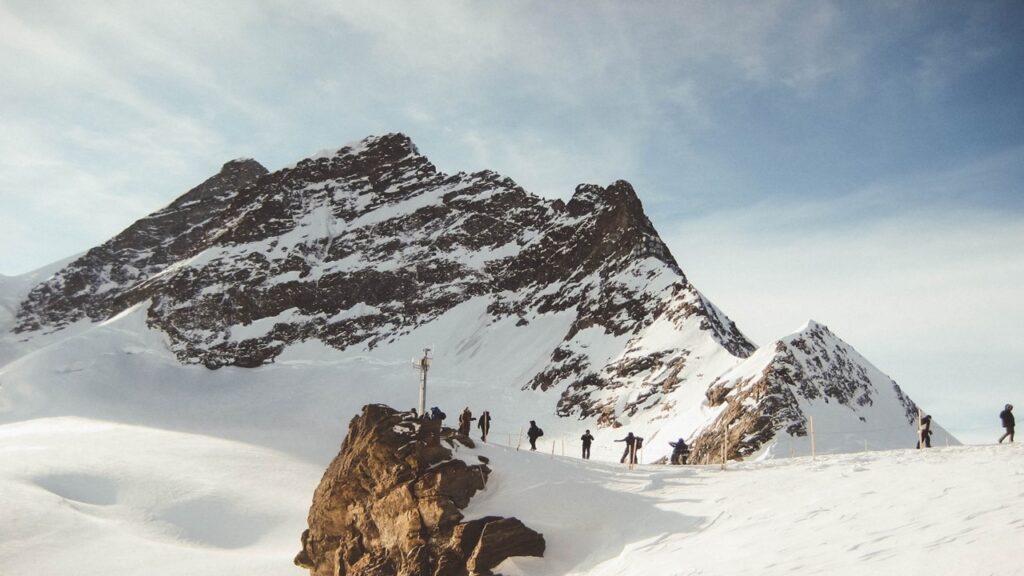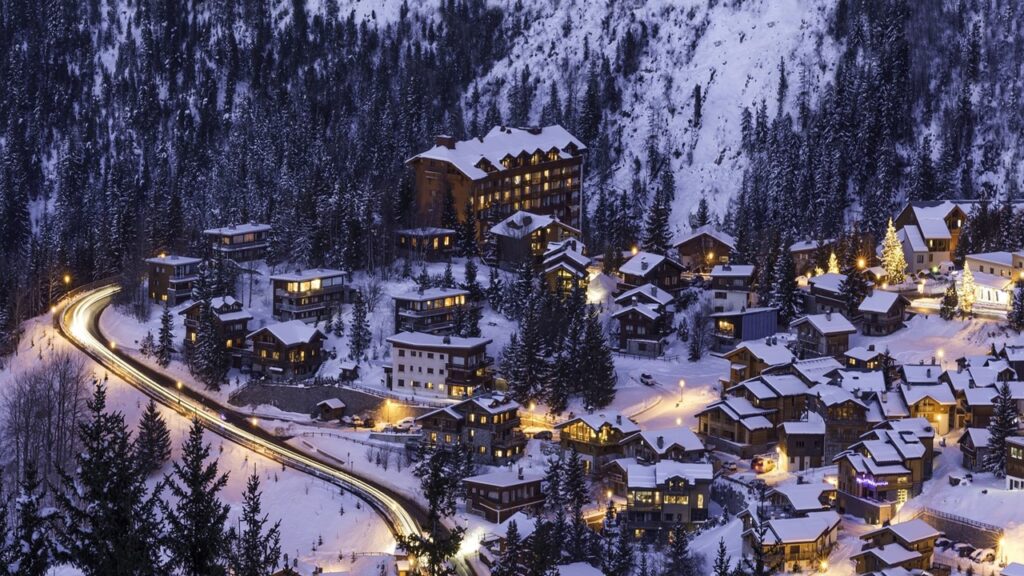Snow Avalanches Explained: Types, Causes and Examples

Snow avalanches are natural hazards that typically take place on snow-covered mountains. They generally occur at any time of the year, but December to April is the most risky period. Snow avalanches can be due to natural reasons like weather or because of humans such as ski runs.
What is a snow avalanche?
A snow avalanche is typically the mass movement of snow, ice and sometimes rocks, vegetation and soil down a slope. The downhill path is typically greater than 50 m. Also, they generally start on slopes that are about 30-45° steep and stop on terrain less than 15°.
As an example, avalanches occur mainly on slopes more than 30° in the Swiss Alps.
Also, they can flow as slow as 20-100 km/h to quite fast at 50-200 km/h. Small avalanches can also carry some 10 tons of materials while extreme ones can displace as much as 100,000 tons!
Avalanche danger scale
We generally rate the danger scale of avalanches according to their destructive power. So,
- Small: In general, they are relatively harmless to us.
- Medium: They could injure or bury someone.
- Large: Large avalanches can destroy cars, small buildings made of wood and some trees.
- Very large: Here, they can destroy several buildings, large trucks, a railway car and a 4 ha forest.
- Extreme: And finally, extreme avalanches can destroy a small village or a forest up to 40 ha.
Stages in a snow avalanche
The International Commission on Snow and Ice describes an avalanche as having three main zones:
- Origin – the starting point,
- Transition – or the track and the
- Runout
Origin of an avalanche
The origin or the starting point is where the avalanche starts. It is usually on higher grounds on terrain steeper than 30°.
Transition of the event
The avalanche then proceeds downhill along the track or transition. This track often consists of gullies and creek beds. If the track is steep, a powder cloud may develop. The avalanche may also plunder straight down regardless of topography. Additionally, some small avalanches may stop in their track while large ones will stop in the runout zone.
Runout
The runout zone is basically the place where the avalanche stops. It is generally on slopes less than 15°. Large avalanches typically stop on alluvial fans where there are man-made infrastructure, residences and businesses in mountain areas.
Types of snow avalanches
Different researchers and organizations categorize avalanches in various ways. Consequently, scientists and practitioners in the field adopted an international snow avalanche classification. So, in general, we categorize avalanches according to their origin, transition and deposition.
Origin
1. Loose snow avalanche
If an avalanche starts from a particular point, we call it a loose snow avalanche.
2. Slab avalanche
A slab avalanche occurs if the break starts from a line.
3. Surface layer avalanche
If the position of failure is within the snowpack, it’s a surface layer avalanche.
4. Full-depth avalanche
But if the break starts on the ground, it’s a full-depth avalanche.
5. Dry-snow avalanche
Now, if there is no liquid in the snow, it’s a dry-snow avalanche.
6. Wet-snow avalanche
But if the avalanche contains water, it’s a wet-snow avalanche.
Transition
7. Unconfined avalanche
Coming to the transition of snow avalanches, if the path is an open slope, it’s an unconfined avalanche.
8. Channeled avalanche
But it the path goes through a channel or gully, we call it a channeled avalanche.
9. Powder snow avalanche
Additionally, if the movement type is in the form of a snow-dust cloud, it’s a powder snow avalanche.
10. Flowing snow avalanche
And if it flows along the ground, it’s a flowing snow avalanche.
Deposition
11. Coarse deposit
As the avalanche finally stops, if the roughness of the deposit is coarse, it’s a coarse deposit avalanche.
12. Fine deposit
If the materials are fine, we call it a fine deposit avalanche.
13. Dry deposit
Likewise, a dry deposit forms if the deposit does not contain water.
14. Wet deposit
Or if it contains water, it’s a wet deposit.
15. Clean deposit
If there is no apparent contamination in the snow, we refer to it as a clean deposit.
16. Contaminated deposit
And if it contains debris like rocks, vegetation and soil, it’s a contaminated deposit.
Factors that lead to snow avalanches
In general, an avalanche starts mainly because of
- slope of the terrain
- roughness of the land
- weather conditions and
- snowpack conditions.
1. Slope of the terrain triggers snow avalanches
Slope is a very important aspect when it comes to avalanches. For example, wet-snow avalanches occur mainly on slopes that face the sun. But dry slab avalanches occur commonly in shaded places. Also, avalanches tend to occur more frequently on convex slopes as they become steeper downslope than on concave slopes.
2. Roughness of terrain
In the same manner, the roughness of the underlying terrain is also critical when it comes to avalanches. As an example, grassy meadows help avalanches to easily glide. But large rocks, stumped trees and logs can halter the movement of small avalanches.
3. Weather conditions
As it is, weather conditions also play a vital role in avalanche formation. It includes temperature, wind direction and speed and storms.
For example, as the temperature lowers in winter, avalanches become common. This is because more snow falls which can destabilize a snowpack.
Wind and storms also increase the load of snow on a snowpack thus leading to snow breaks.
4. Snowpack conditions
The different layers in a snowpack also affect the release of snow. Sometimes they can be a few centimetres to several feet deep. They can change within a day due to weather conditions and form different types of layers over different seasons.
For example, rain can make the snow more gluey and hence more prone to fall. Conversely, cold temperatures can strengthen the bonds in the snowpack and make it more resistant to breaks.
Type of releases during a snow avalanche
As it is, there are basically two types of release during an avalanche: loose snow avalanche and slab avalanche.
Loose snow avalanche
As the name suggests, loose snow avalanches start from a particular point in a loose layer of dry or wet snow. We also call them sluffs. They are generally small and harmless. Such avalanche typically occurs below the point where it was disturbed.
Slab avalanche
In slab avalanches, a sticky slab breaks over an extended place of weakness. They usually occur soon after storms which increase the snow load. Slab avalanches begin above the point of disturbance. As the bonds between the slab breaks, ice chunks can rush downhill sometimes at a speed of more than 130 km/hr.
What causes snow avalanches
Natural causes of snow avalanches
1. Heavy snowfall and rainfall
In general, avalanches occur due to excessive snow load on a particular snowpack. Heavy snowfall and rainfall especially do that. As a result, the bonds between the snow layers weaken leading to avalanches. For example, heavy rainfall triggered avalanches in Kashmir in 2020 killing 59 people.
2. Strong winds
In the same manner, strong winds can transport materials and deposit them on a snowpack. The wind speed generally determines how much materials can be carried. So, strong winds greater than 60 mph often carry and deposit materials further down slopes. As they accumulate on the snowpack, they can trigger avalanches.
3. Storms
Additionally, storms add new snow to a snowpack. Hence, coupled to strong winds, the load on a particular slab can easily double to quadruple. As a consequence, the snow breaks.
4. Volcanic eruptions and Earthquakes
Likewise, volcanic eruptions and earthquakes send tremors in snow packed mountainous areas. As a result, vibrations disturb snow layers leading to avalanches. In the Andes region of Argentina and Chile, volcanic eruptions and earthquakes frequently cause avalanches.
5. Global warming
With global warming comes climate change that leads to climate variability. Sometimes it’s cold, then warm and then cold again. Consequently, it affects the composition of a snowpack as well as local weather conditions. For example, studies show that there are now more wet snow avalanches in spring in Switzerland.
Human causes of snow avalanches
1. Outdoor winter activities
Today, however, most avalanches occur because of us. Backcountry tourists often wander in risky zones and trigger avalanches by stepping into weak zones. It can either be due to their weight or the activity (climbing, hiking, snowmobiling etc.) that they are doing.

Off-piste skiing trigger snow avalanches
Likewise, off-piste skiers also initiate them with more devastating consequences. As a matter of fact, the managers of ski resorts must ensure that ski pistes are safe before people can ski. But when people go off-piste, that is, away from the safe region to look for clean snow, they often trigger avalanches.
2. Avalanche control
Avalanche control is when we cause avalanches on purpose. Mountain rescue services generally trigger small events using explosives like TNT to prevent bigger ones from happening. Ski resorts, mountain towns and railway lines must in fact do so to protect communities. We basically undertake avalanche control under safe conditions, making sure that people are not around.

Predicting snow avalanches
In regions where snow avalanches occur frequently, avalanche-forecasting services inform people of the probability of their occurrence. However, it is very difficult to estimate a single event at a particular place and time specifically. This is because of the complex interaction between the snowpack, land and weather conditions.
References:
- Haeberli, W., Whiteman, C.A. and Shroder, J.F. eds., 2014. Snow and ice-related hazards, risks, and disasters. Waltham, MA: Academic Press.
- Maggioni, V. and Massari, C. eds., 2019. Extreme Hydroclimatic Events and Multivariate Hazards in a Changing Environment: A Remote Sensing Approach. Elsevier.

Pingback: Effects of Snow Avalanches: Positive, Negative, Examples - Yo Nature